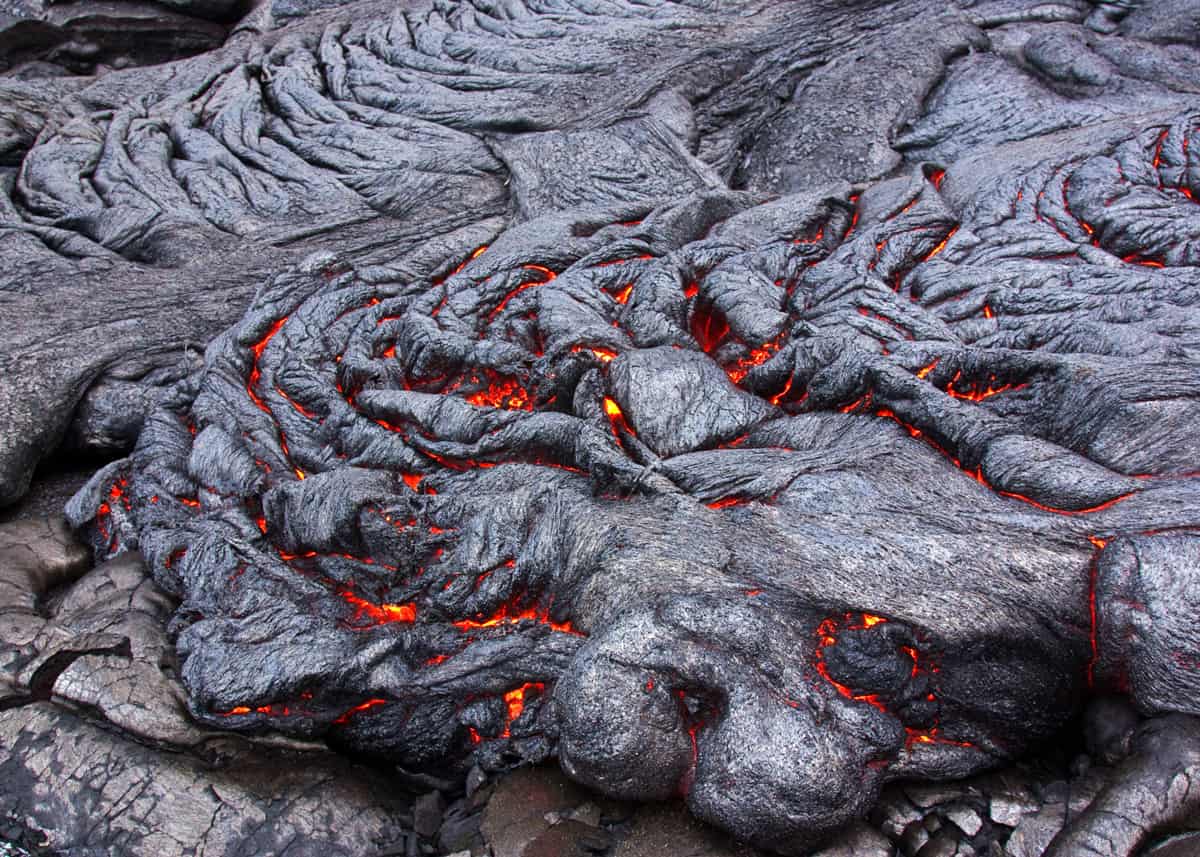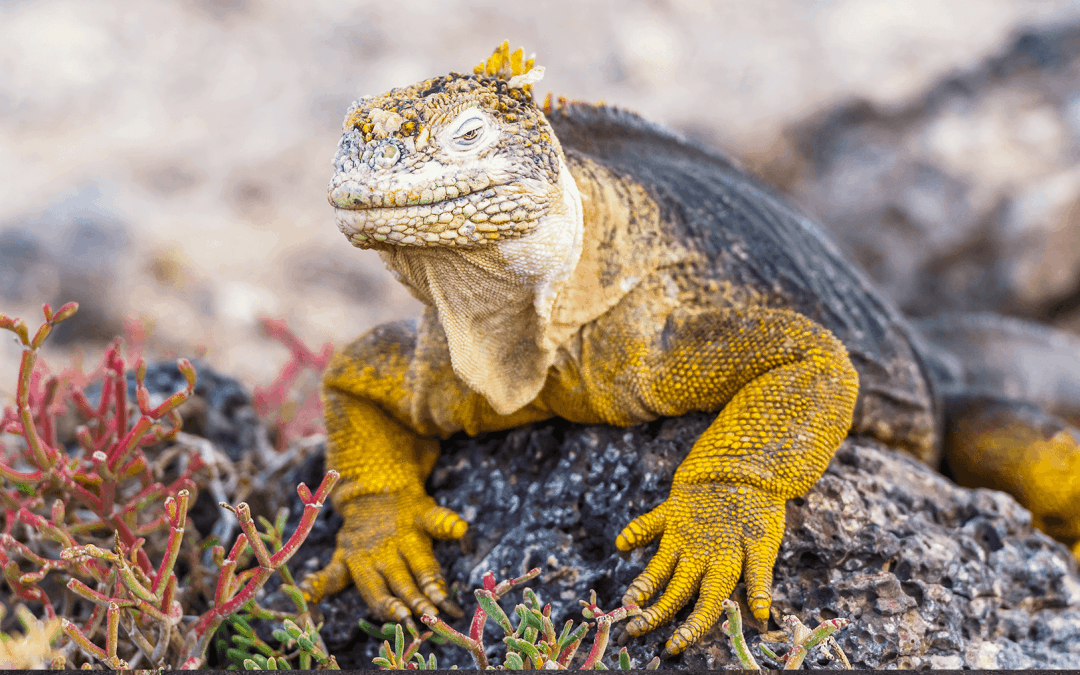It’s fascinating to see different types of lava flow, especially if it’s your first time. In the Galapagos, you’re likely to see at least three kinds, this post is all about what they look like and how they are formed.

Pahoehoe lava – hot and flowing
3 Types of Lava Flow You’ll See in the Galapagos
The types of lava flows you’re most likely to see in the Galapagos Islands are made up of basaltic lava which comes from mafic lava. The mafic lava is molten rock which comes from the earth’s mantle. It is enriched with magnesium and iron, but lower in silica and aluminium. When mafic lava cools it forms what is called a basaltic lava flow.
The basaltic lava flows look different based on how fast they flow, their viscosity (thickness), and what circumstances they encounter along the way. Many of the names of lava flows come from Hawaii because the majority of lava study and discovery has taken place there.
These are the three main basaltic lava flows you are likely to see in the Galapagos:
- Aa, pronounced “ah-ah”
- Pahoehoe, pronounced “pa-howe-howe”
- Pillow lava
Let’s take a closer look at each kind.

Pahoehoe lava that has formed a lava tube[/caption]
What is Aa lava?
Aa lava is made up of loose chunks of basaltic lava which are sharp and jagged. They are carried along the top of the flow and tumble around as it moves across the landscape. The loose lava blocks/rocks moving and tumbling along the way are called clinkers.
Some say this type of lava got its name because of the sound you make when you walk on it in your bare feet – “ah ah ah ah”. In Hawaiian it means stony rough lava.
This lava is formed when relatively thin (low viscosity) molten rock flows over the landscape. It would be good to keep the texture of this lava in mind when packing for the Galapagos and include some good sturdy footwear. It’s very interesting to see how easily the marine iguanas, penguins, fur seals and sea lions make their way over the volcanic landscape.
The following video from Hawaii, shows what an aa lava flow looks and sounds like. That clinking sound is similar to the sound you’ll hear as you walk across this type of lava flow.
Watch on YouTube

Check out our guide to Galapagos Islands names
What is Pahoehoe Lava?
Pahoehoe lava is a type of basaltic lava that is smooth and thicker (higher viscosity) than aa lava. In Hawaiian, pahoehoe means smooth, unbroken lava. It creates interesting shapes and natural sculptures across the landscape. As it flows a skin or crust forms on the top layer which then gives way allowing another flow – which forms a skin, and so on.
These types of lava flow can form lava tubs. Pahoehoe can also turn into an aa lava flow if it becomes thinner (loses its viscosity) and/or flows faster.
This video shows pahoehoe lava being formed, you’ll notice that when it hardens it still looks much like it did when it was molten and flowing.
Watch on YouTube

What is Pillow Lava?
Pillow lava is created when basaltic lava flows into water, or emerges from a volcanic vent under the water.
When the magma reaches the water it forms a skin or crust which is then broken by more magma pushing against it. As these skins are continually broken by fresh magma they make pillow shapes.
You’re most likely to see these types of lava flow when you are walking on the beach, snorkeling or scuba diving.
In the following video you’ll see pillow lava being formed under the water.
Watch on YouTube


Will You See Lava on the Galapagos Islands?
It is exciting to see evidence of the way these islands were formed! The pahoehoe is a favorite for photographers, and you won’t soon forget the sound of the aa clanking under your feet if you get the chance to walk across it.
As you’re traveling the islands it helps to keep your camera handy so you can capture the landscape as you drive. No doubt your guide will explain the types of lava flow as you explore and you’ll have a chance to photograph it up close as well.

Related Tours

Galapagos Best Deal
This program is a great deal to discover the great Galapagos Islands on a budget, while visiting some of the most iconic places and visitor sites in Santa Cruz Island.

Cruising the Galapagos Islands
Cruising the Galapagos Islands The Galapagos Islands, also known as The Enchanted Islands, are located around the Equator in the Pacific Ocean, approximately 600 miles west of continental...

Isabela Island at Scalesia Lodge
Exploring Isabela Island At Scalesia Galapagos Lodge5,4 or 3 DAYS Program Scalesia Galapagos Lodge is in the highlands of Isabela, about 20 minutes from Puerto Villamil. The resort is nestled...

The Best of Galapagos
The Best of Galapagos8 DAYS / 7 NIGHTSA great option to explore Galapagos by Land & Sea! Spend a week in the Galapagos visiting some of the most iconic islands and visitor places. Explore...

Galapagos By Land & Sea
Galapagos By Land & Sea(Operates from Wednesday to Sunday)5 DAYS / 4 NIGHTSGalapagos is one of the must-see and visit places in the world, a unique paradise on earth where humans can get...
Ecuador Phone: (593) 2-3801125 / 2-3801149 Email: info@latinrootstravel.com Skype: latinrootstravel.ecuador Latin Roots Travel Av del Establo y Calle E, Centro Corporativo Financiero Site Center, Torre 3, Oficina 107, Quito – Ecuador
Powered by Auveron Studio


